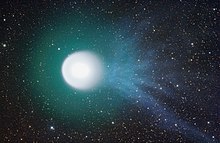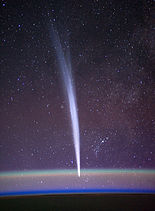
Back ذيل المذنب Arabic Хвост каметы Byelorussian Cua (cometa) Catalan Kometa vosto Esperanto Cola (astronomía) Spanish Isats (kometa) Basque دم (دنبالهدار) Persian Queue de comète French Rep kometa Croatian Պոչ (գիսաստղ) Armenian


A comet tail and coma are visible features of a comet when they are illuminated by the Sun and may become visible from Earth when a comet passes through the inner Solar System. As a comet approaches the inner Solar System, solar radiation causes the volatile materials within the comet to vaporize and stream out of the nucleus, carrying dust away with them.
Blown solar downwind, two separate tails are formed: one composed of dust and the other of gases. They become visible through different phenomena: the dust reflects sunlight directly, and the gases glow from ionization. Most comets are too faint to be visible without the aid of a telescope, but a few each decade become bright enough to be visible to the naked eye.
© MMXXIII Rich X Search. We shall prevail. All rights reserved. Rich X Search

